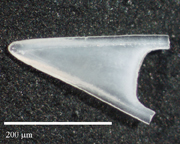 Ancient fish
teeth are taking a bite out of an old conundrum about how Antarctica became
the frigid continent that it is today. The teeth suggest an early start to key
oceanic processes that drove the climatic shift.
Ancient fish
teeth are taking a bite out of an old conundrum about how Antarctica became
the frigid continent that it is today. The teeth suggest an early start to key
oceanic processes that drove the climatic shift.

 Ancient fish
teeth are taking a bite out of an old conundrum about how Antarctica became
the frigid continent that it is today. The teeth suggest an early start to key
oceanic processes that drove the climatic shift.
Ancient fish
teeth are taking a bite out of an old conundrum about how Antarctica became
the frigid continent that it is today. The teeth suggest an early start to key
oceanic processes that drove the climatic shift.
This fossil fish tooth, only a few tenths of a millimeter long, and many more like it provide evidence that Pacific and Atlantic waters mixed earlier than scientists previously thought. Photo is by Howie Scher.
Antarctica once flourished with boreal forests and a temperate climate. Then, about 34 million years ago the climate changed and quickly turned the continent into a huge ice sheet (see Geotimes, March 2006).
The culprit for the sudden change, according to some paleoclimatologists, was the onset of the Antarctic Circumpolar Current (ACC) — a cold current that encircles Antarctica and isolates the continent from warm subtropical waters. For the ACC to form, however, there needed to be an open passageway around Antarctica without restrictions from neighboring continents. “As long as there’s no barrier there, the current can just spin up and go around,” says Ellen Martin, a paleoclimatologist at the University of Florida in Gainesville.
Although the opening of the Tasmanian Gateway between Australia and Antarctica is thought to have spurred formation of the current, another ocean opening event — of the Drake Passage between South America and Antarctica — could have kick-started the necessary oceanic processes. Geoscientists have long debated the timing of the opening of the Drake Passage: Previous estimates based on continental plate spreading have placed the event anywhere from 20 million to 45 million years ago, lending some uncertainty about the event’s suspected effect on climate.
Now, Martin and Howie Scher of the University of Rochester in New York have used isotopic data to zero in on a period 41 million years ago for the opening of the Drake Passage. The new date places it before the opening of the Tasmanian Gateway, but in time to make the Drake Passage a key player in the cooling down of Antarctica, they report in the April 12 Science.
To date the opening, Martin’s team analyzed micrometer-sized fossil fish teeth extracted from core samples pulled from the southern Atlantic Ocean. Fish teeth absorb the element neodymium, which rivers carry from nearby rocks into Earth’s oceans. Neodymium that comes from young volcanic rocks into the Pacific Ocean, however, has a different isotopic ratio than the same element that comes from older rocks into the Atlantic Ocean.
Measurements of neodymium in teeth from the Atlantic turned up a large change in the element’s ratio at about 41 million years ago. The change reflects water from the Pacific mingling with water in the Atlantic, implying that the Drake Passage had opened, Martin says. “By showing that we could see the Pacific water coming through, we’re adding a little more credence to the numbers,” she says.
While the shift indicates that the Drake Passage opened by that time, it does not speak to the depth of the passage nor how much water was mixing. “It’s a little harder to get a handle on that,” Martin says.
Lawrence Lawver, a marine geophysicist at the University of Texas in Austin, agrees that continental plate movements may have allowed a shallow Drake Passage to have opened by 41 million years ago, but that a deep opening by that time is “highly unlikely.”
Still, Martin and colleagues suggest that even a shallow opening of the Drake Passage would be enough to start nutrient upwelling in the oceans that would have drawn down carbon dioxide from the atmosphere. That change would have created a cooling that contributed to a corresponding momentary period of Antarctic glaciation prior to the long-term event that started 34 million years ago, Martin says.
Shallow or deep, the timing of the Drake Passage opening places it well before the Tasmanian Gateway opening, which scientists think deepened between 35.5 million and 33.3 million years ago. The Tasmanian opening likely established an open path for the ACC to flow, thanks in part to upwelling processes that started earlier with the Drake Passage opening. “What our date does,” Martin says, is show that the Drake Passage is “old enough now that it could have played a key role in helping make Antarctica cold.”
Kathryn Hansen
Links:
"Drilling Back to the
Future," Geotimes, March 2006
 |
Geotimes Home | AGI Home | Information Services | Geoscience Education | Public Policy | Programs | Publications | Careers |